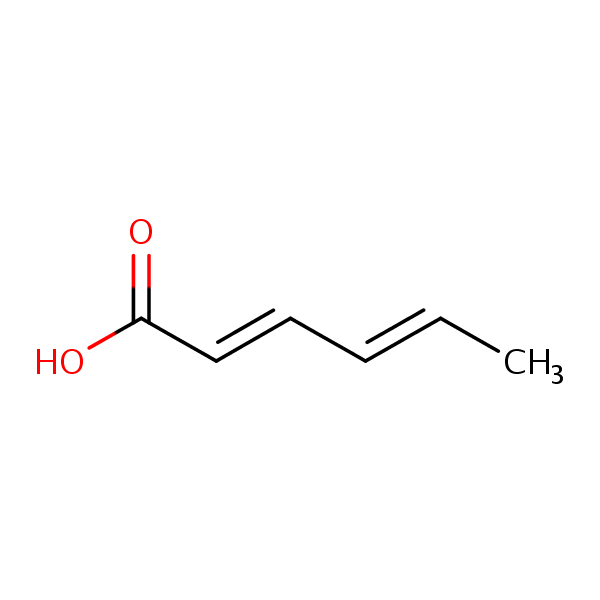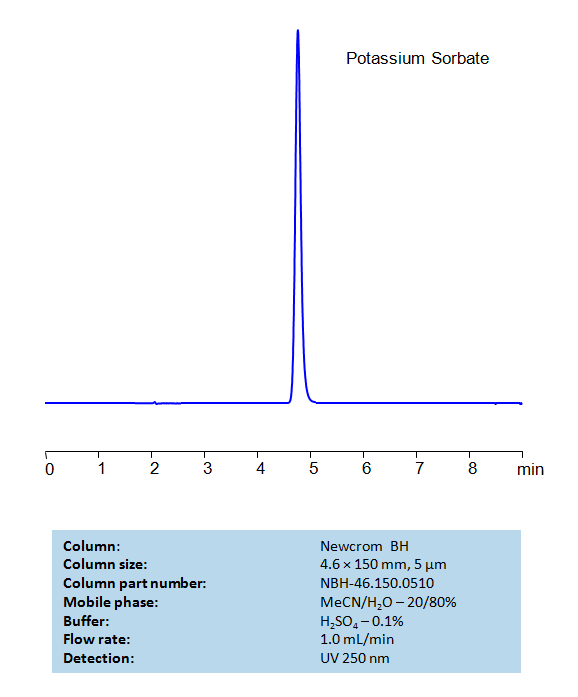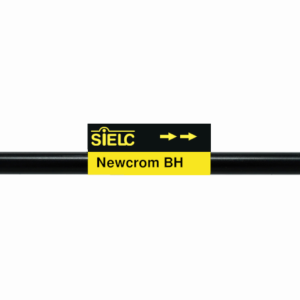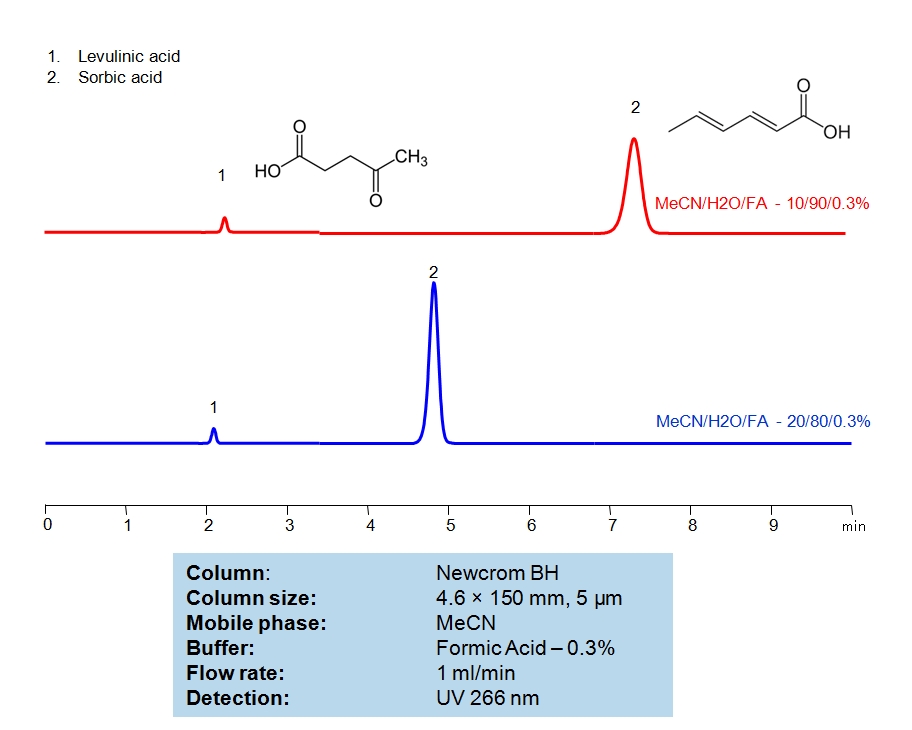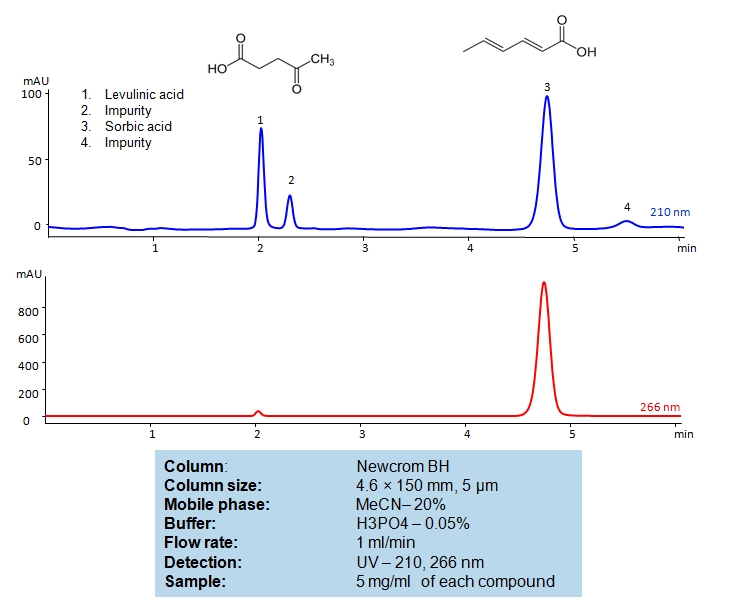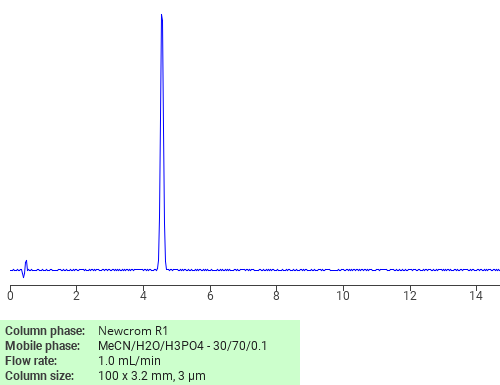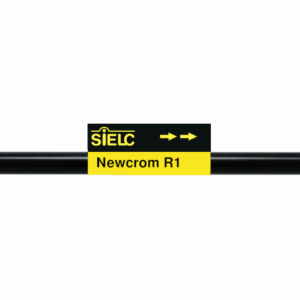| CAS Number | 110-44-1 |
|---|---|
| Molecular Formula | C6H8O2 |
| Molecular Weight | 112.128 |
| InChI Key | WSWCOQWTEOXDQX-MQQKCMAXSA-N |
| LogP | 1.33 |
| Synonyms |
|
Applications:
HPLC Method for Analysis of Potassium Sorbate on Newcrom BH Column
May 10, 2022
Potassium Sorbate is a popular preservative used in a wide variety of foods, wines, and personal-care products. Potassium Sorbate can be retained and analyzed on a mixed-mode Newcrom BH column with a mobile phase consisting of water, Acetonitrile (MeCN), and Sulfuric acid (H2SO4). This analytical method can be UV detected at 210 nm with high resolution and peak symmetry.
Application Column
Newcrom BH
The Newcrom columns are a family of reverse-phase-based columns. Newcrom A, AH, B, and BH are all mixed-mode columns with either positive or negative ion-pairing groups attached to either short (25 Å) or long (100 Å) ligand chains. Newcrom R1 is a special reverse-phase column with low silanol activity.
Select optionsSorbic acid

HPLC Separation of Levulinic acid and Sorbic Acid on Newcrom BH Column
June 30, 2020
HPLC Method for Levulinic acid, Sorbic acid on Newcrom BH by SIELC Technologies
High Performance Liquid Chromatography (HPLC) Method for Analysis of Levulinic acid, Sorbic acid.
Levulinic acid is used as a precursor for a wide variety of compounds and is used extensively in pharmaceuticals and cosmetics industries. Despite that, when ingested, it can be harmful. It has the chemical formula C5H8O3.
Sorbic acid is used as a preservative in food, drinks, and cosmetics. It works through inhibiting the growth of molds, yeasts, and some bacteria. While it is considered safe, studies have connected it to hyperactivity in children when mixed with other additives. It has the chemical formula C6H8O2.
The two acids can be separated in HPLC using Newcrom BH mixed-mode column using a mobile phase of acetonitrile (ACN) and water and either phosphoric acid (H3PO4) or formic acid (FA) as buffer allowing the the use of either UV or MS detector.
| Column | Newcrom BH, 4.6 x 150 mm, 5 µm, 100 A, dual ended |
| Mobile Phase | MeCN/H2O |
| Buffer | H3PO4, Formic Acid |
| Flow Rate | 1.0 ml/min |
| Detection | UV 210, 266 nm |
| Class of Compounds | Acid |
| Analyzing Compounds | Levulinic acid, Sorbic acid |
Application Column
Newcrom BH
Column Diameter: 4.6 mm
Column Length: 150 mm
Particle Size: 5 µm
Pore Size: 100 A
Column options: dual ended
Sorbic acid

HPLC Separation of Sorbic, Fumaric, Malonic Acids on Newcrom BH Column
June 25, 2020
HPLC Method for Sorbic acid, Fumaric Acid, Malonic Acid on Newcrom BH by SIELC Technologies
High Performance Liquid Chromatography (HPLC) Method for Analysis of Sorbic acid, Fumaric Acid, Malonic Acid.
Sorbic acid is used as a preservative in food, drinks, and cosmetics. It works through inhibiting the growth of molds, yeasts, and some bacteria. While it is considered safe, studies have connected it to hyperactivity in children when mixed with other additives. It has the chemical formula C6H8O2.
Fumaric Acid, also known as trans-butenedioic acid, is an organic compound with C4H4O4 chemical formula. It is used across food, industrial, and medical industries. In food, is it often used as a preservative, pH regulator, and flavoring akin to citric acid. Industrially, it is used in making polyester resins, polyhydric alcohols, and more. Medically, it is used in denture cleaners and it’s derivatives are used in treating psoriasis.
Malonic Acid is an organic acid with the C3H4O4 chemical formula. It has a variety of uses from synthesis to preservatives. When it comes to synthesis, it is often used in industrial means. and especially dyes for natural fibers. Besides industrial use, in laboratory environments, it is used in preparation of tris-maleate, sodium maleate buffers, and maleate salts.
You can find detailed UV spectra of Fumaric Acid and information about its various lambda maxima by visiting the following link.
Acids with different strengths can be retained and elution order controlled by the use of a mixed-mode column, which has an ion-exchange component in addition to hydrophobic retention. In this example, the Newcrom BH mixed-mode column was used to separate fumaric, malonic and sorbic acids in HPLC. Sorbic acid was mostly retained by hydrophobicity, while fumaric and malonic acids were also retained by the adjustment strength of the mobile phase
| Column | Newcrom BH, 4.6 x 150 mm, 5 µm, 100 A, dual ended |
| Mobile Phase | MeCN/H2O – 20/80% |
| Buffer | H3PO4 |
| Flow Rate | 1.0 ml/min |
| Detection | UV 200nm |
| Class of Compounds | Acid |
| Analyzing Compounds | Sorbic acid, Fumaric Acid, Malonic Acid |
Application Column
Newcrom BH
Column Diameter: 4.6 mm
Column Length: 150 mm
Particle Size: 5 µm
Pore Size: 100 A
Column options: dual ended
Malonic Acid
Sorbic acid

Separation of Sorbic acid on Newcrom R1 HPLC column
February 16, 2018
Sorbic acid can be analyzed by this reverse phase (RP) HPLC method with simple conditions. The mobile phase contains an acetonitrile (MeCN), water, and phosphoric acid. For Mass-Spec (MS) compatible applications the phosphoric acid needs to be replaced with formic acid. Smaller 3 µm particles columns available for fast UPLC applications. This liquid chromatography method is scalable and can be used for isolation impurities in preparative separation. It also suitable for pharmacokinetics.
Application Column
Newcrom R1
The Newcrom columns are a family of reverse-phase-based columns. Newcrom A, AH, B, and BH are all mixed-mode columns with either positive or negative ion-pairing groups attached to either short (25 Å) or long (100 Å) ligand chains. Newcrom R1 is a special reverse-phase column with low silanol activity.
Select options